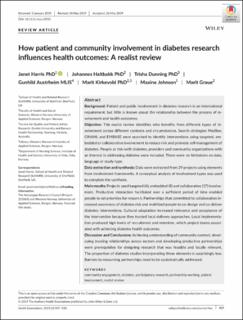| dc.contributor.author | Harris, Janet | |
| dc.contributor.author | Haltbakk, Johannes | |
| dc.contributor.author | Dunning, Trisha | |
| dc.contributor.author | Austrheim, Gunhild | |
| dc.contributor.author | Kirkevold, Marit | |
| dc.contributor.author | Johnson, Maxine | |
| dc.contributor.author | Graue, Marit | |
| dc.date.accessioned | 2020-03-16T07:30:21Z | |
| dc.date.available | 2020-03-16T07:30:21Z | |
| dc.date.created | 2019-11-10T13:04:15Z | |
| dc.date.issued | 2019 | |
| dc.identifier.citation | Harris, J., Haltbakk, J., Dunning, T., Austrheim, G., Kirkevold, M., Johnson, M. & Graue, M. (2019). How patient and community involvement in diabetes research influences health outcomes: A realist review. Health Expectations, 22(5), 907-920. | en_US |
| dc.identifier.issn | 1369-6513 | |
| dc.identifier.uri | https://hdl.handle.net/11250/2646848 | |
| dc.description.abstract | Background
Patient and public involvement in diabetes research is an international requirement, but little is known about the relationship between the process of involvement and health outcomes.
Objective
This realist review identifies who benefits from different types of involvement across different contexts and circumstances. Search strategies Medline, CINAHL and EMBASE were searched to identify interventions using targeted, embedded or collaborative involvement to reduce risk and promote self‐management of diabetes. People at risk/with diabetes, providers and community organizations with an interest in addressing diabetes were included. There were no limitations on date, language or study type.
Data extraction and synthesis
Data were extracted from 29 projects using elements from involvement frameworks. A conceptual analysis of involvement types was used to complete the synthesis.
Main results
Projects used targeted (4), embedded (8) and collaborative (17) involvement. Productive interaction facilitated over a sufficient period of time enabled people to set priorities for research. Partnerships that committed to collaboration increased awareness of diabetes risk and mobilized people to co‐design and co‐deliver diabetes interventions. Cultural adaptation increased relevance and acceptance of the intervention because they trusted local delivery approaches. Local implementation produced high levels of recruitment and retention, which project teams associated with achieving diabetes health outcomes.
Discussion and Conclusions
Achieving understanding of community context, developing trusting relationships across sectors and developing productive partnerships were prerequisites for designing research that was feasible and locally relevant. The proportion of diabetes studies incorporating these elements is surprisingly low. Barriers to resourcing partnerships need to be systematically addressed. | en_US |
| dc.language.iso | eng | en_US |
| dc.publisher | Wiley | en_US |
| dc.rights | Navngivelse 4.0 Internasjonal | * |
| dc.rights.uri | http://creativecommons.org/licenses/by/4.0/deed.no | * |
| dc.subject | community engagement | en_US |
| dc.subject | diabetes | en_US |
| dc.subject | participatory research | en_US |
| dc.subject | partnership working | en_US |
| dc.subject | patient involvement | en_US |
| dc.subject | realist review | en_US |
| dc.title | How patient and community involvement in diabetes research influences health outcomes: A realist review | en_US |
| dc.type | Peer reviewed | en_US |
| dc.type | Journal article | en_US |
| dc.description.version | publishedVersion | en_US |
| dc.rights.holder | © 2019 The Authors | en_US |
| dc.source.pagenumber | 907-920 | en_US |
| dc.source.volume | 22 | en_US |
| dc.source.journal | Health Expectations | en_US |
| dc.source.issue | 5 | en_US |
| dc.identifier.doi | 10.1111/hex.12935 | |
| dc.identifier.cristin | 1745733 | |
| dc.relation.project | Norges forskningsråd: 221065 | en_US |
| cristin.ispublished | true | |
| cristin.fulltext | original | |
| cristin.qualitycode | 1 | |

